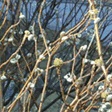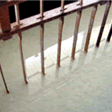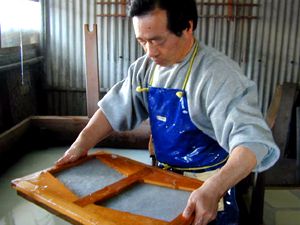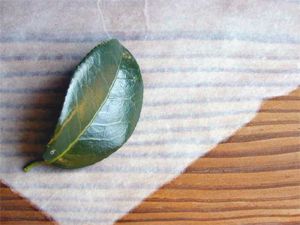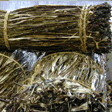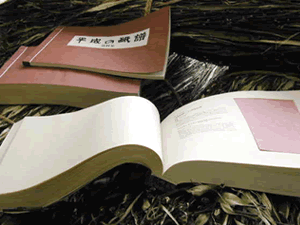
 |
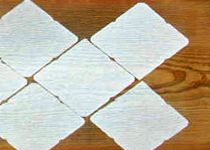 |
|||
 |
||||
|
|
Yoshifumi
Okatsu ’s Itamegami Along with Shimanto River and Yoshino River, Niyodo River ranks among the major rivers of Shikoku. On the bank of the Niyodo River, is Yoshifumi Okatsu’s paper mill. One of the critical conditions for washi making is to be close to clean water sources as washi making requires great amount of water. This is why the major paper making villages in Japan are located by the river. In Feature 002 we would like to introduce Yoshifumi Okatsu’s itamegami (washi with distinctive wood grain imprints), created along the clear riverbank. The word itamegami may be unfamiliar to many. It is a type of thin washi with prominent wood grain patterns, (as the word literally means “wood grain paper”), transferred from the wood board during the drying process. Wood bark is peeled and torn into fiber strips, to make the liquid of mashed fine fibers. The thin film scooped from water on the screen is wood fibers intertwined together making one sheet of paper. The impression of wood grains is imprinted onto the sheet laid on the wooden board to dry. This process truly depicts and reminds us once again that paper is made from wood. Okatsu-san grew up in a paper making family. The family has a history of 70 years in the trade starting from his grandfather’s generation. His father never asked him to be his successor, however, Okatsu-san began his career at a laboratory where he could learn more about paper. At the laboratory, he was able to study not only about the washi his family specialized in, but also conduct researches on other types of washi. He has over 30 years of experience in this craft and is a master of washi making. How is Itamegami Made?Okatsu-san's washi paper mill is nestled in the middle of beautiful landscape where the air is very refreshing. Visiting the mill I was able to see itamegami actually being made. The photos show the various stages of process in the making of itamegami, from when it is scooped from the pulp water stock until its finished stage. The raw materials often used for washi making are Kozo (Broussonetia kazinoki Sieb., family Moraceae), Mitsumata (Edgeworthia papyrifera Sieb. et Zucc., family, Thymelaecea, genus Edgeworthia), Gampi (Diplomorpha sikokiana Nakai, family, Thymelaeacea, genus Diplomorpha). Naturally, as washi is often called "rice paper", rice straw was often used as raw material as well as bamboo and mulberry. Okatsu-san's itamegami uses mitsumata mixed with a fiber called exparto. By combining short fibers, it gives a sense of light and soft finish, which enhances the imprint of the wood grains. Okatsu-san experimented extensively to find the best combination of fibers to bring out the best quality in the imprint of the wood grain, and this combination was judged to bring the desired texture (photo 1, Mitsumata tree with its white bark).
Okatsu-san uses the method called tamezuki (photo 2, tororo-aoi -Hibiscus manihot- mucilage is added to the pulp solution and stirred well). The process of tamezuki is as follows: the pulp stock is scooped onto a screen mold in the vat, and the wet sheet is removed from the mold after the water drains and the fibers settle on the mold (photo 3). Until this stage, the process of papermaking is same as any other washi making. The popular drying method used today are the heated stainless steel plates. This method allows the wet sheets to dry regardless of the bad weather outside. The paper making process can be carried out at a rhythmical pace, and produce uniform quality washi. Until the heated drying plate was introduced, in most paper making villages, wood drying boards were taken outside and placed facing the sun, in front of the houses and all around the garden to sun dry. The process is repeated, as washi is removed once it is dry, and new wet sheets are laid on the wooden board, and taken outside to dry. Of course, this process of washi making by hand and sun drying is greatly influenced by the weather and is at times inefficient. Nowadays, only paper makers who have particular taste for making quality washi prefer this traditional process regardless of the time and care it requires. |
|||||||||||
|
Okatsu-san dedicated to follow the trade by continuing the traditional method, of hand laid, board dried washi. This method has now become somewhat a luxury item in Japan. His wooden boards are made from pine tree. The old wood with most of its resin secreted has the distinctive, prominent wood grain patterns. At times, however, resin causes brownish stain marks on the papers sheets laid to dry. Bad weather causes lye to forms, as the wet sheets are left to dry on the surface, over a longer period of time. The beauty of itamegami is found in the distinctive texture, the slightly different hues, and the individually different wood grain patterns transferred from the drying boards. The popular woods used for drying boards is not pine, but woods such as Ginnan (Ginko tree) with fine grain that leaves minimum trace marks of the grain patterns. This is because shodo paper (ink writing paper), shoji paper (sliding door paper), fusuma paper (thick sliding partition paper), and paper used for repairing and restoring Japanese paintings and manuscripts, requires the surface to be extremely even and smooth. At the Tosa Paper Craft Center located in Ino-cho, one can still find today, a drying board of approximately one meter in width made of ginko wood, that is only used occasionally to make sun dried washi (photo 4). You can easily distinguish the handmade, sun dried washi with its luster, grain patterns and slightly different variations of the color white.
Carefully without twisting, the wet pulp film scooped in a mold is transferred onto the drying board, avoiding any prominent grain holes (photo 5). The most dramatic stage comes next. Okatsu-san walks swiftly across to his neighbor’s garden and collects several shiny camellia leaves. The leaves are shiny and healthy with the abundant sunrays it receives in the southern country of Shikoku. Holding the leaves into his hands, using the top surface, he begins to scrub with vigor across the wet sheets laid on the drying board (photo 6,7). This process is to remove any air bubbles between the wood surface and the wet sheet, and to press the sheet to stick firmly onto the wood surface. It also flattens the fibers and forms a stronger sheet as it dries contracting with the board. During the summer time, this process carried out under the blazing sunrays, becomes quite tedious causing perspiration to drip from his forehead. It requires much attention and strength focused on each of his fingertips. This is definitely hard work as he stands bending over the board, straining his back. The paper adhering tightly onto the wood surface is then left to dry in his sunny garden. On a bright dry day, the sheets will dry within three hours. (photo 8)
|
|||||||||||
|
Worrying Statistic Concerning the Future of Handmade WashiThe history of Tosa washi can be traced back to the Heian period (end of 12th century), as recorded in Engishiki (collection of canons compiled into 50 volumes from Engi era, regarding court life, religious ceremonies and tax collection). Under the guidance of the staff at the laboratory where he received his training, Okatsu-san experimented in the reconstruction of old washi for the Tosa Washi Tai-kan (Encyclopedia of Tosa Washi) published in 1990. It took Otsuka-san and his colleagues more than two years to complete the research and restoration. His experiment entailed in examining the old washi paper, surmising the contents of raw materials, and studying the process of scooping, drying and adding dye. Although today, Tosa is still a historical paper industry village, producing for a large percentage of the market share, figures regarding handmade washi are not very encouraging. In 1902, when handmade paper flourished, there existed 68,562 households engrossed in this industry. However, by the year 1976, the number decreased to 636 households, and by 1983, to 479 papermaking households, showing the drastic decrease occurring at a rapid rate. Even in Tosa City, where the village boasted high standard and number of production of washi, the households that specializes in papermaking decreased to almost 30 households today. Good news, however, did reach us recently. Four young gentlemen have started their own handmade papermaking business. handmadejapan.com believes that in order for the young generation to learn the traditional washi making and continue his trade and foster successors, it is imperative to find and promote further method to utilize washi in our daily modern lives. |
|||||||||||
